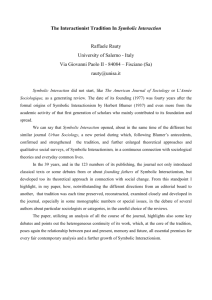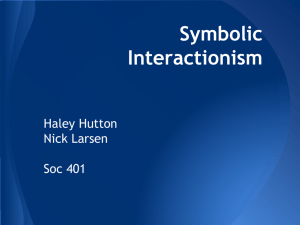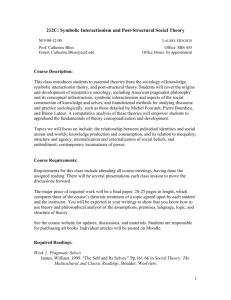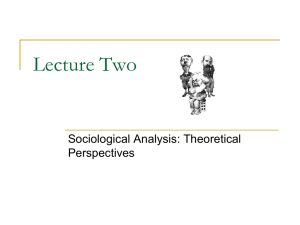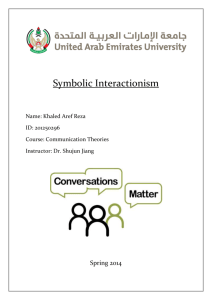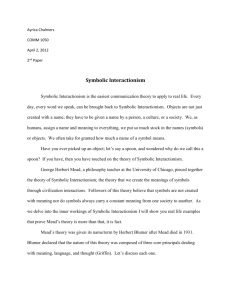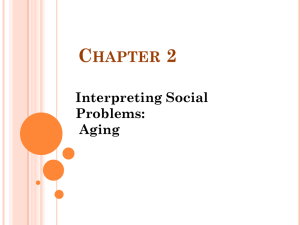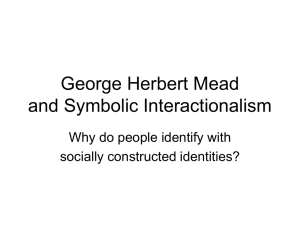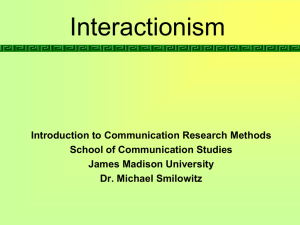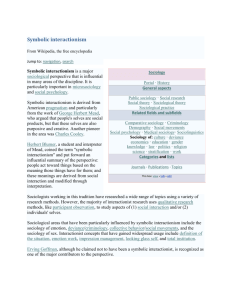QUAL 8400 Social Interactionism Paper with Instructor Comments
advertisement
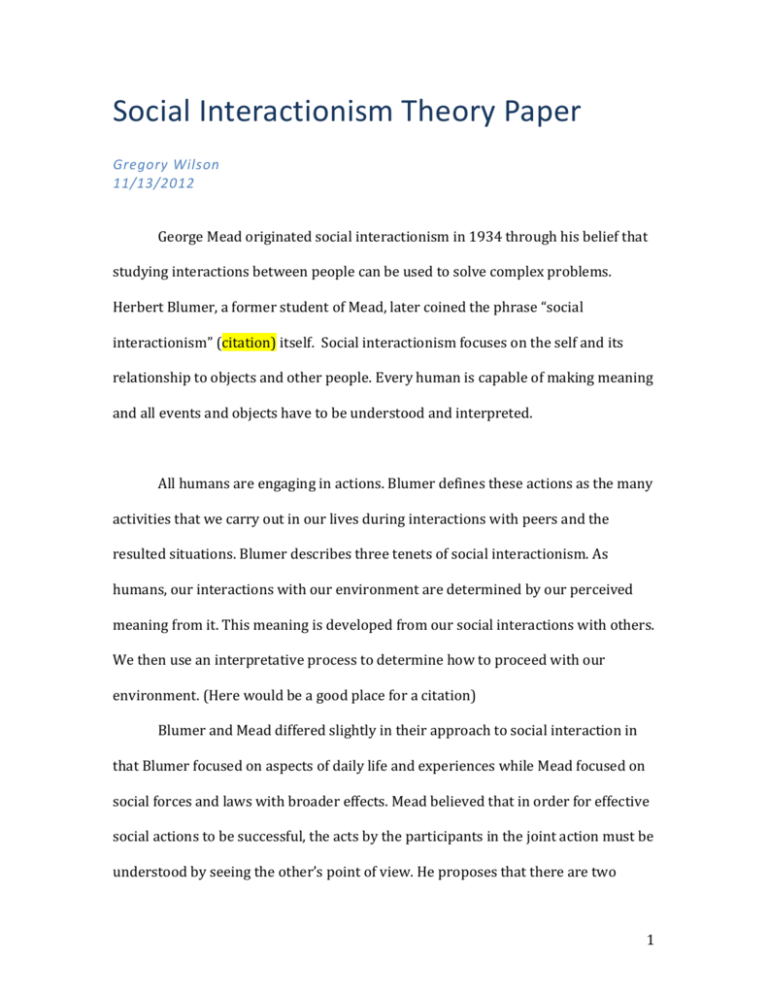
Social Interactionism Theory Paper Gregory Wilson 11/13/2012 George Mead originated social interactionism in 1934 through his belief that studying interactions between people can be used to solve complex problems. Herbert Blumer, a former student of Mead, later coined the phrase “social interactionism” (citation) itself. Social interactionism focuses on the self and its relationship to objects and other people. Every human is capable of making meaning and all events and objects have to be understood and interpreted. All humans are engaging in actions. Blumer defines these actions as the many activities that we carry out in our lives during interactions with peers and the resulted situations. Blumer describes three tenets of social interactionism. As humans, our interactions with our environment are determined by our perceived meaning from it. This meaning is developed from our social interactions with others. We then use an interpretative process to determine how to proceed with our environment. (Here would be a good place for a citation) Blumer and Mead differed slightly in their approach to social interaction in that Blumer focused on aspects of daily life and experiences while Mead focused on social forces and laws with broader effects. Mead believed that in order for effective social actions to be successful, the acts by the participants in the joint action must be understood by seeing the other’s point of view. He proposes that there are two 1 forms of social interactions – the conversation of gestures and the use of significant symbols. Mead defined gestures, as being found in any part of a current action that exemplifies the larger act it is apart of. An example of these forms of interactions can be found in a classroom. When a teacher makes a point or gesture in class, they first have to see the need for the use of the action and anticipate possible reactions from the students. Once the gesture is made, the students internally process this action and construct patterns through this collaborative action. Face to face social encounters are considered important as they form human conduct and behavior. Snyder and Spretizer describes the idea of our behaviors being a result of thoughtful and reflective actions instead of external stimuli as one of the most important points in symbolic interactionism (citation). Gusfield (year) described meaning and situations as being transmitted through language using what he calls “verbal symbols” (citation) A symbolic interactionist’s research methods favors direct observation of an empirical social world over creating a lab based simulation. When conducting research through the viewpoint of social interactionism, human subjects are though of as agentive actors in the creation and interpretation of meaning. Symbolic interactionists also seek to discover how these meanings are recreated, changed, or adjusted. They emphasize the construction and understanding of meaning through constant social interactions in diverse settings. Any method that involves collecting the subject’s thoughts and reactions to social situations would be useful for a 2 symbolic interaction study. The researcher cannot assume the meaning of events, objects, and situations but must take the perspective of the participants by studying human behavior. Gusfield (year) warns that the observer must have prior knowledge about the intended subjects before relevant research problems and appropriate methods of studies can be created. An example use of symbolic interactionism in research can be found in Teo and Osborne’s study on a STEM high school teacher’s experience in curriculum reform. Specifically, the instructor wanted to add more inquiry based learning to his science courses. In this study, the researchers wanted to understand an instructor’s process with attempting change the science curriculum. They specifically studied the sociopolitical and sociocultural context of this process. The researchers sought to understand what the instructor wanted to achieve, how he went about constructing, interpreting, and applying meanings, and how these meanings changed as he brought his theories into the curriculum enactment through interactions with different people and contexts. One research question that fueled the study is what does it mean to do inquiry curriculum reform through interactions. Data from this study was collected from transcribed interviews, descriptive narratives of the lesson activities, interactions, curriculum materials, and school website information. Through this information, the researchers were able to understand the instructor’s intended curriculum changes, his definition of inquiry, curriculum work process in the summer, and reflections on curriculum change plans of the following year. 3 Hund and Knaus looked at Looking-Glass Self, which is a sub theory of symbolic interactionism. Charles Cooley, another originator of social interactionism, created this sub theory in 1902. It involves self-awareness and reflexivity and the idea that a person constructs an opinion of one’s self based on how others view him. The researchers describe the classroom as a place for shared expectations built on the participants’ interactions with each other, which shape behavior and expected roles. They hypothesize that the instructor and students need to be aware of their Looking Glass Selves so that successful classroom collaboration and learning can occur. More importantly, students need to believe that the instructor understands their educational goals and needs. This type of expectation promotes a democratic classroom equipped with diverse viewpoints and experiences. Kathy Charmaz (year) envisioned the future of symbolic interactionism as getting back to the basic principles. She views future research as advancing the theoretical views of symbolic interactionism. She argues that symbolic interactionism should be explored in new empirical areas while being open to new theoretical possibilities. She views the construction of sophisticated and useful interpretations of social life as the primary future potential of symbolic interactionism. I can see the benefits in adding social interactionism to my constructionism theoretical framework. I want to conduct my research with the viewpoint that 4 learning is a social activity and knowledge can be socially constructed. Chapman and Resnick propose that people learn through their interactions and their knowledge is constantly constructed and renegotiated. Students should have many opportunities to construct and share knowledge with their peers. My current research interests are centered on students participating in design teams. Participating in design requires effective interactions and negotiation within the team for the experience to be successful. While there are many tools that promote collaborating aboard, face-to-face talk is still very much needed in the practice of design. Oak (year) talks about the discussion that happens during the design process. He proposes that creativity and constraints of the design process are constantly managed and performed by the design team. Thinking about the other participants and figuring out their point of view during interactions are an important part of participating in design. As Oak highlights in his research, symbolic interactionism can be used to better understand how the verbal interactions of designers expresses the reflections, assessments, and beliefs that help shape the objects they design. The theory can highlight the problem solving process of a designer and how it impacts the team. Many research studies comment on the difficulty students have with working together on a project. Vaajakallio and Lee found that children aged 7 to 8 year olds had challenges in participating equally in the group work and seemed to follow quite openly their personalities and roles: the active ones seemed to dominate the 5 team activity while the shy ones remained more passive. Kwon and Cifuentes found that students in their study were not motivated to collaborate with each other and were distracted by each other and the technology. I believe there needs to be more research done on how students work together in groups especially when a problem has to be solved or an artifact has to be created. I have not seen many studies that interview students who are apart of a design team and discuss the process of design. I think potential research questions with a social interactionist approach would include: What does it mean to design or solve problems through interactions? What are the students’ opinions of their design partners and how do they think others view them? What does it mean to ideate and share ideas with others? These questions can be essential in creating more positive collaborative experiences for students. References: 1.) Blumer, H. (1986). Symbolic Interactionism: Perspective And Method 2.) Chapman, R. N., & Resnick, M. (2006). Pearls of Wisdom: Technology for Intentional Reflection and Learning in Constructionist Cooperatives. Massachusetts Institute of Technology. 3.) Charmaz, K. (2008). A Future For Symbolic Interactionism. Studies in Symbolic Interaction, 32 51-59. 6 4.) Gusfield, J. R. (2012). A Journey with Symbolic Interaction. Symbolic Interaction, 26(1), 119–139. 5.) Hund, A., & Knaus, K. (2011). Re ( Imagining ) Teacher Preparation Through Symbolic Interactionism and the Looking-Glass. Complicity: An International Journal of Complexity and Education, 8(1), 51–57. 6.) Kwon, S. Y., & Cifuentes, L. (2007). Using Computers to Individually-generate vs. Collaboratively-generate Concept Maps. Educational Technology & Society, 10(4), 269–280. 7.) Oak, A. (2011). What can talk tell us about design?: Analyzing conversation to understand practice. Design Studies, 32(3), 211–234. 8.) Snyder, E. E., & Spreitzer, E. (1984). Identity and commitment to the teacher role. Teaching Sociology, 11, 151–166. 9.) Vaajakallio, K., & Lee, J. (2009). “ It has to be a group work !” - Co-design with Children. Proceedings of the 8th International Conference on Interaction Design and Children - IDC ’09 (pp. 3–6). 10.) Wee, T., & Margery, T. (2012). Using symbolic interactionism to analyze a specialized STEM high school teacher’s experience in curriculum reform, 541–567. 7
